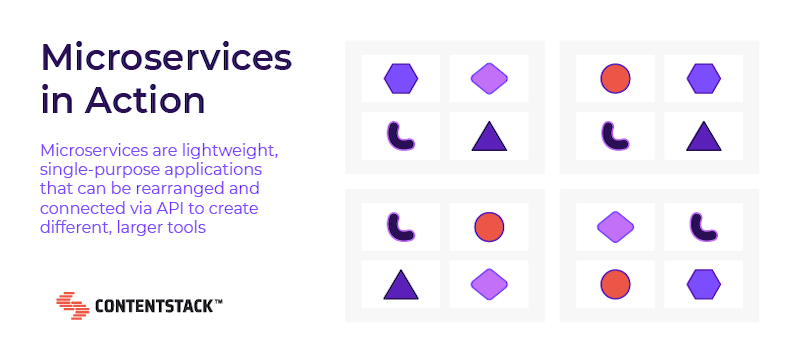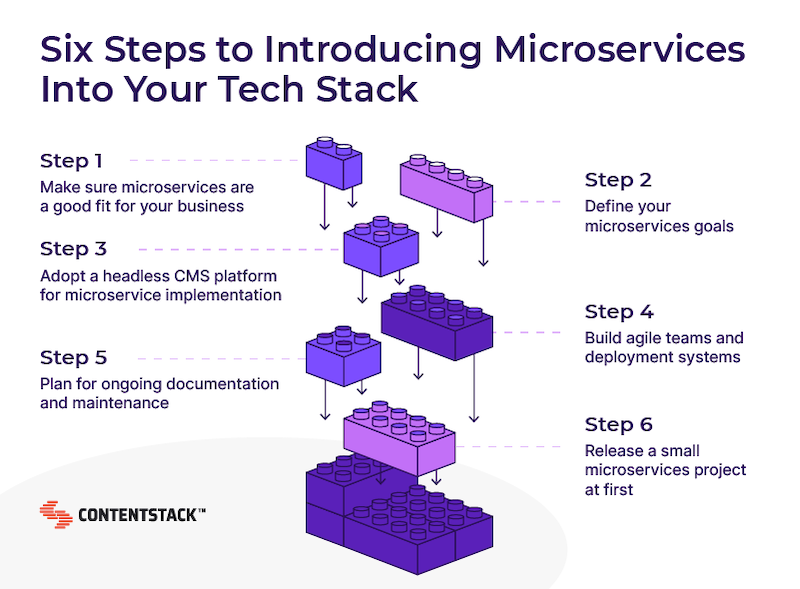Microservices: the ultimate guide

The vast majority of marketing software has been created following a monolithic architectural approach. That is to say the frontend, backend, and all the various functions of the software are inextricably connected and share a single codebase. No big deal, right? Maybe not in the past, when the most marketing that a business needed to do was publish static content to a single, static website.
Today, monolithic marketing software doesn’t serve modern marketing organizations — organizations that need to keep up with consumers who engage with content across various channels, devices, and platforms 24/7. Scaling traditional, monolithic marketing software to keep up with demand is complicated, expensive, and, frankly, unnecessary considering the more advanced modern marketing software that exists today.
As an enterprise marketing or IT leader, you’re looking for marketing technology that can grow with your needs — not grow your needs for more personnel, more server space, and more spending. You may not know it just yet; that means you’re looking for microservices.
Join us in this ultimate guide to microservices as we dive into:
- Exactly what microservices are
- The benefits you can expect when working with modern microservices instead of outdated monoliths
- How to start integrating microservices into your marketing workflow today
What are microservices and how do they work?
Microservices may be small in stature, but it’s that size that gives them their power. Microservices can be defined as lightweight, single-purpose applications. In microservice-based software architecture, these microservices can be easily added, rearranged, and removed at any time to create custom tools that are ready to deliver on any business function, at any time.
The custom tools that consist of microservices are called “decoupled” or “headless” because they lack a centralized workflow or management. Microservices can communicate and work together toward a common goal with application programming interface (API) technology that enables applications to, well, interface!

Microservices are a foundational element of MACH technology. MACH is a pioneering approach to software built on four fundamental principles: Microservices, API-connectivity, cloud-nativity, and headless infrastructure. MACH technology is defined by its integrability, scalability, and ease of evolution.
By taking a microservices approach to marketing software, companies can build (and rebuild!) tech stacks that are always on the cutting edge of modern software and marketing best practices.
On the other hand, with monolithic marketing software, updating code to adjust even a single service impacts the entire platform. If anything goes wrong, critical marketing systems may go down while your team scrambles to rebuild and redeploy the whole platform. Compared to a monolithic structure in which everything is interrelated, microservices offer the flexibility modern marketers need.
The benefits of microservices
You’ve probably caught on to this by now, but there are numerous business benefits of using microservices.
Enjoy limitless integrations — without the strings
There’s no question that a microservices architecture is the best path for enterprise marketing organizations that prioritize integrating their CMS with modern extensions for localization, personalization, and beyond.
However, this level of integration often causes complications if the software isn’t built for it, not so with microservices. Thanks to the flexible approach that microservices offer, if a single service experiences setbacks or needs to be removed or updated for any reason, that doesn’t prevent other services from performing as planned.
Take advantage of better, more affordable scalability
Because microservices aren’t tied together and instead communicate and operate by way of APIs, scaling up (or down) certain pieces of your microservices-based marketing platform as needed is fairly simple. That means you can enjoy continuous up-time and flawless performance when it comes to business-critical services without worrying about breaking the whole system — or the tangled web of add-ons bolted to the system to get it up to speed — like you would with a monolithic platform.
In addition to the time and headache this saves technology teams, it can also save your business money by requiring that you only scale the services that are essential to you in the moment, not the entire expensive application.
Outpace competitors with unprecedented flexibility
Because microservices are independently deployable and scalable, as we discussed above, this makes them so flexible that they can be written in different languages and managed by different departments!
This previously unheard-of level of flexibility means multiple areas of your team can work together to upgrade your marketing technology and push revolutionary marketing experiences before your competitors even know what hit them.
Get key business and marketing capabilities to market at warp speed
Microservices deliver highly specific services in which enterprise business users are interested. Think of business capabilities such as compliance management or marketing capabilities like personalization. And due to their individually deployable and manageable nature that we’ve described, microservices that deliver these capabilities can be spun up and pushed to market almost as soon as you realize you need them.
With a microservices-based platform, getting key capabilities to market quickly is never hampered by the platform the way it is with interconnected monolithic platforms.

How to introduce microservices into your tech stack
Hopefully, the above points have you considering implementing microservices into your marketing workflow. In that case, we think you’re on the right path to achieving greater flexibility and scalability across your marketing department and campaigns. The last step is making the moves to introduce microservices into your marketing technology! The following six steps help you do just that.
Step 1: make sure microservices are right for your marketing team
Before moving forward with implementing microservices, you should decide whether they’re genuinely a good fit for your marketing team’s requirements, capabilities, and desires. Remember, you are building what is likely to be a complex application. So you should have access to sufficient engineering talent and microservices expertise within your workforce.
If you lack microservices expertise and only need a simple application for a small team, an already-done monolithic approach may be more suited to your needs. If you believe microservices are ultimately for you, consider investing in long-term microservices support or training and development.
Step 2: define microservices goals, outline how you’ll achieve them
A blueprint. A roadmap. A plan. Whatever you call it, you need a way to document your goals for microservices and define how you’re going to move toward them.
This is crucial because due to microservices’ individual nature, your number of services can quickly add up — creating complexity and chaos if you don’t have a clear plan for where everything goes and how it should all work together.
It all starts with identifying the specific services you need to deliver your desired new business or marketing capabilities. These will, of course, look very different from company to company.
Whether you’re building from scratch using a microservices architecture or transitioning from monolithic architecture by implementing microservices selectively, this step is about identifying the boundaries between services.
Again, it all comes down to what’s best for your business. Suppose you currently use a monolithic architecture and anticipate that you’ll only ever need to scale one or two specific services. In that case, you may want to retain your monolithic structure but gradually connect new microservices using APIs. This will allow you to grow and update these microservices at a different rate than the rest of your software.
If you’re going for a full-on microservices approach but aren’t starting from scratch, you may still choose to follow a similar process but slowly replace all the pieces of your monolithic platform over time.
Step 3: adopt a headless CMS platform
A headless architecture enables you to develop and deploy your backend independently of your frontend to lay the foundation for effective microservices implementation.
When using headless architecture to implement microservices, you’ll be able to develop each service independently. These individual services are then connected using a lightweight integration protocol that allows them to call on one another whenever the need arises — typically an API, as we’ve described before.
Adopting a headless content management system (CMS) can dramatically simplify implementing microservices for marketing. Specifically, a headless CMS enables your content team to build, deploy, optimize, and manage content modules efficiently without interfering with the design and development that also goes into publishing content across channels and devices.

This headless approach means your various teams can work independently to create modern marketing experiences, and your CMS will never hold you back from using the latest technology. Additionally, an API-first CMS platform such as Contentstack will also come with all the advanced content management features you need and make it a breeze to integrate with capabilities that enable personalization, ecommerce, and beyond.
Step 4: build agile teams and deployment plans
Just like microservices themselves, your implementation project team should be small, cross-functional, and agile.
This team will need clearly defined goals and the autonomy to own their microservices and make quick decisions as needed. You should also encourage these teams to adopt short and similarly agile development cycles characterized by thorough testing and iteration for rapid and deployment and integration.
Be meticulous about fostering a culture of collaboration and communication among teams to avoid siloing that can result from mostly autonomous teams.
Step 5: create a documentation and maintenance schedule
With dozens or even hundreds of microservices running simultaneously across departments, your microservices-based marketing platform will often be in a state of flux. This fluctuation can make it difficult for a developer to pick up where another left off if they need to change a service or patch a bug.
To this end, you must create a culture in which high-quality technical documentation and setup instructions go hand-in-hand with coding. Monitoring and logging tools that track the system’s state around the clock and record errors are also crucial maintenance for keeping all the moving parts running together smoothly.
Step 6: start small
As microservices prove, small can be mighty. No matter whether you’re going all-in on microservices across your entire business or you’re just adding in a few new services, start with a small project so that you can learn and perfect your process as you make your way toward more extensive projects.
Starting small may even mean rolling out just one single microservice at the beginning. This approach allows your teams to gain a solid understanding of the technical requirements of your new decoupled architecture and how to work within it effectively. By moving slowly, you’ll all be able to fail, iterate, and learn together in a controlled environment.

Learn more about where microservices can take your marketing
From enabling your marketing department to take advantage of powerful integrations to offering affordable scalability and outpacing competitors with unheard-of flexibility, microservices may be among the smallest applications. Still, they promise some of the most significant benefits.
If you want to learn how to break out of the monolith and adopt microservices-based MACH marketing architecture that will propel you forward at the speed of modern business, download Break the Replatform Cycle with MACH Enterprise Architecture for free to read about:
- How to determine if microservices and MACH technology are right for your team
- How to evaluate the quality of MACH-based solutions
- How specific enterprises have found success with microservices and MACH
- And more benefits of moving to a MACH architecture
About Contentstack
The Contentstack team comprises highly skilled professionals specializing in product marketing, customer acquisition and retention, and digital marketing strategy. With extensive experience holding senior positions in notable technology companies across various sectors, they bring diverse backgrounds and deep industry knowledge to deliver impactful solutions.
Contentstack stands out in the composable DXP and Headless CMS markets with an impressive track record of 87 G2 user awards, 6 analyst recognitions, and 3 industry accolades, showcasing its robust market presence and user satisfaction.
Check out our case studies to see why industry-leading companies trust Contentstack.
Experience the power of Contentstack's award-winning platform by scheduling a demo, starting a free trial, or joining a small group demo today.
Follow Contentstack on Linkedin




.svg?format=pjpg&auto=webp)
.svg?format=pjpg&auto=webp)
.png?format=pjpg&auto=webp)






.png?format=pjpg&auto=webp)

